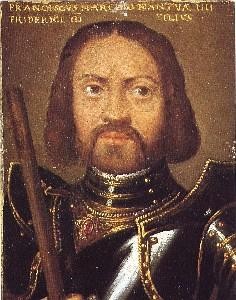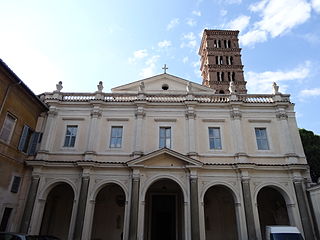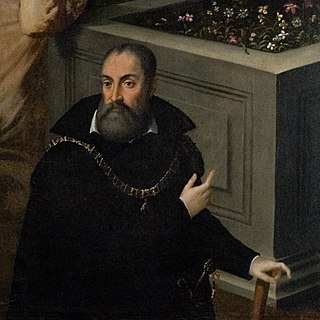 Guidi di Bagno family coat of arms | |
| Origin | |
|---|---|
| Region of origin | Mantua, Italy |
The House of Guidi di Bagno is an old Italian noble family which moved first into Romagna (Bagno di Romagna) [1] and then into Mantua from the 14th century.
 Guidi di Bagno family coat of arms | |
| Origin | |
|---|---|
| Region of origin | Mantua, Italy |
The House of Guidi di Bagno is an old Italian noble family which moved first into Romagna (Bagno di Romagna) [1] and then into Mantua from the 14th century.
The branch of the family originated from Riccardo count Guidi di Bagno who married Philippa Gonzaga di Novellara, niece of Feltrino Gonzaga.
Among the most important leaders of this family, it may be noted:

Mantua is a city and comune in Lombardy, Italy, and capital of the province of the same name.

Francesco II Gonzaga was the ruler of the Italian city of Mantua from 1484 until his death.

Ludovico III Gonzaga of Mantua, also spelled Lodovico was the ruler of the Italian city of Mantua from 1444 to his death in 1478.

Luca Marenzio was an Italian composer and singer of the late Renaissance.
Jacquet of Mantua was a French composer of the Renaissance, who spent almost his entire life in Italy. He was an influential member of the generation between Josquin and Palestrina, and represents well the transitional polyphonic style between those two composers.

Guastalla is a town and comune in the province of Reggio Emilia in Emilia-Romagna, Italy.
The counts of Nevers were the rulers of the County of Nevers, which became a French duchy in 1539, with the rulers of the duchy calling themselves dukes.

The Duchy of Mantua was a duchy in Lombardy, Northern Italy. Its first duke was Federico II Gonzaga, member of the House of Gonzaga that ruled Mantua since 1328. The following year, the Duchy also acquired the March of Montferrat, thanks to the marriage between Gonzaga and Margaret Paleologa, Marchioness of Montferrat.

Sabbioneta is a town and comune in the province of Mantua, Lombardy region, Northern Italy. It is situated about 30 kilometres (19 mi) north of Parma, not far from the northern bank of the Po River. It was inscribed in the World Heritage List in 2008.

The Palazzo Ducale di Mantova is a group of buildings in Mantua, Lombardy, northern Italy, built between the 14th and the 17th century mainly by the noble family of Gonzaga as their royal residence in the capital of their Duchy. The buildings are connected by corridors and galleries and are enriched by inner courts and wide gardens. The complex includes some 500 rooms and occupies an area of c. 34,000 m2, which make it the sixth largest palace in Europe after the palaces of the Vatican, the Louvre Palace, the Palace of Versailles, the Royal Palace of Caserta and the Castle of Fontainebleau. It has more than 500 rooms and contains seven gardens and eight courtyards. Although most famous for Mantegna's frescos in the Camera degli Sposi, they have many other very significant architectural and painted elements.

Bagno di Romagna is a comune (municipality) in the Province of Forlì-Cesena in the Italian region Emilia-Romagna, located about 90 kilometres (56 mi) southeast of Bologna and about 45 kilometres (28 mi) south of Forlì.

The Basilica dei Santi Bonifacio e(d) Alessio is a basilica, rectory church served by the Somaschans, and titular church for a cardinal-priest on the Aventine Hill in the third prefecture of central Rome, Italy.

Louis Gonzaga, Duke of Nevers was a soldier, dignitary and diplomat in France. By marriage he became the Duke of Nevers and was a patron of the arts. Louis is believed to be one of the courtiers responsible for the St. Bartholomew's day massacre. He died in 1595 at Nesle.

Ferrante I Gonzaga was an Italian condottiero, a member of the House of Gonzaga and the founder of the branch of the Gonzaga of Guastalla.

The Diocese of Mantua is a Latin Church ecclesiastical territory or diocese of the Catholic Church in Italy. The diocese existed at the beginning of the 8th century, though the earliest attested bishop is Laiulfus (827). It has been a suffragan of the Archdiocese of Milan since 1819.
Vincenzo Gonzaga was the reigning Duke of Guastalla and a member of the House of Gonzaga.

Nicola Guidi di Bagno or Nicolò Guidi di Bagno was a titular archbishop of Atenia, bishop of Senigallia, and a cardinal. He descended from a noble family. His brother Gianfrancesco Guidi di Bagno and his uncle Girolamo Colonna were also cardinals.
Guidi is an Italian surname shared by several notable people:

Francesco Gonzaga was an Italian bishop and a Cardinal of the Roman Catholic Church during the reigns of Popes Pius II, Paul II and Sixtus IV.

Giovanni Francesco Guidi di Bagno (1578–1641) was an Italian cardinal, brother of cardinal Nicola Guidi di Bagno and nephew of cardinal Girolamo Colonna.